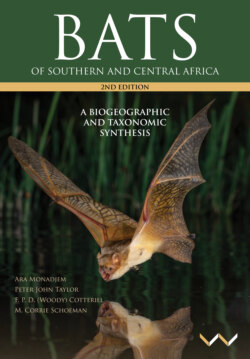Читать книгу Bats of Southern and Central Africa - Ara Monadjem - Страница 63
На сайте Литреса книга снята с продажи.
ОглавлениеEpomops franqueti (Tomes 1860)
Franquet’s epauletted fruit bat Least Concern
Description: Epomops franqueti is a large bat with a mass over 150 g in adult males and around 120 g in adult females. The pelage is greyish-brown. The wings are dark brown. Adult males are much larger than females, and may be distinguished by a broader muzzle with a folded upper lip and the presence of shoulder epaulettes. These epaulettes are pockets containing long, white fur that can be erected to display prominent white shoulder patches. At rest, these patches disappear as the fur is retracted into the pocket. The ears have a patch of white fur at their base. The muzzle is dog-like and broader than that of similar-sized Epomophorus species.
The skull is robust with sturdy zygomatic arches. In lateral profile, the rostrum and interorbital region are rather flat, while the parietal region is deflected downwards. From above, the rostrum is broad. There are eight palatal ridges present: three thick undivided ridges within the last molar and five divided ridges beyond it. The dental formula was 1121/2132 = 26 in two skulls from the Makerere University Collection and not 2121/2132 = 28 as stated by Rosevear (1965).
| External measurements (mm) and mass (g) for Epomops franqueti, sexes combined | |||||
|---|---|---|---|---|---|
| Mean | Min | Max | SD | N | |
| Mass 1 | 114.7 | 72.0 | 178.0 | 35.86 | 7 |
| FA 1 | 93.5 | 87.6 | 103.4 | 5.25 | 7 |
| Total 2 | 126.0 | 110 | 150 | - | - |
| Tail 2 | 0 | - | - | - | - |
| Tibia 3 | - | 32.0 | 37.5 | - | - |
| Ear 2 | 22.0 | 19 | 25 | - | - |
| CI | - | - | - | - | - |
1 Measured by A. Monadjem in Uganda (Monadjem et al. 2011)2 Happold (1987)3 Rosevear(1965)
Key identification features: The combination of white patches at the base of the ears and shoulder epaulettes (males) separates Epomops and Epomophorus from other large fruit bats. Palatal ridges immediately separate these two genera, with Epomophorus exhibiting six narrow ridges (eight thick ridges in E. franqueti). Epomops franqueti is easily distinguished from E. dobsonii by the number of post-dental palatal ridges (five in E. franqueti, two in E. dobsonii).
Echolocation call: This bat does not echolocate.
Distribution, habitat and roosting: Epomops franqueti is a common rainforest inhabitant of Central and West Africa, but is marginal to southern Africa. So far, it has only been recorded from the southern DRC and northwestern Angola, with a single specimen from extreme northeastern Zambia (Ansell 1978). However, it may be more widely distributed in the far northern parts of Angola and the southwestern DRC. The type specimen is from Gabon (MNHN A 107, Holotype).
The southern African population of this species is poorly represented in museums, with only seven records examined for this book.
Nothing is known about its roosting habits in southern Africa, but in West Africa it hangs in trees. It is associated with closed forest, but may venture into open habitats (e.g. villages) to feed on fruiting trees that are situated close to forest.
Extralimital: Epomops franqueti is widespread in tropical African forests occurring in Uganda, Sudan, DRC, Congo, Central African Republic, Gabon, Cameroon, Equatorial Guinea, Nigeria, Benin, Togo, Ghana and Côte d’Ivoire.
Foraging ecology: Epomops franqueti has broad wings with high wing loading (19.4 N.m-2) and low aspect ratio (6.5) (Norberg and Rayner 1987). There is no information on the diet or foraging behaviour of this species in southern Africa, but elsewhere it is known to feed on the following plants: Mangifera spp., Annona spp., Terminalia catappa, Persea americana, Artocarpus spp., Ficus spp., Psidium guajava, and Solanum torvum (Kingdon 1974, Fujita and Tuttle 1991).
Figure 59. Skull and teeth of Epomops franqueti: (a) dorsal view, (b) ventral view, (c) lateral view, and (d) lateral mandible view (FMNH 160215).
Reproduction: In Angola, two immature bats were collected in September (Bergmans 1989).
Figure 60. Roosting Epomops franqueti, showing white ear tufts (Uganda, © A. Monadjem).
SYSTEMATIC NOTES
1860.Epomops franqueti Tomes, Proc. Zool. Soc. Lond. 1: 54, pl. 75. Gabon.
The names comptus H. Allen 1862 and strepitans K. Andersen 1910 are synonyms. Epomops franqueti is closely related to the West African E. buettikoferi, but the latter species does not occur further east than Liberia (Monadjem and Fahr 2007).
The diploid number in E. franqueti is 2n = 36 and FN = 68 (Haiduk et al. 1980).
1 Measured by A. Monadjem in Uganda (Monadjem et al. 2011)
2 Happold (1987)
3 Rosevear(1965)
